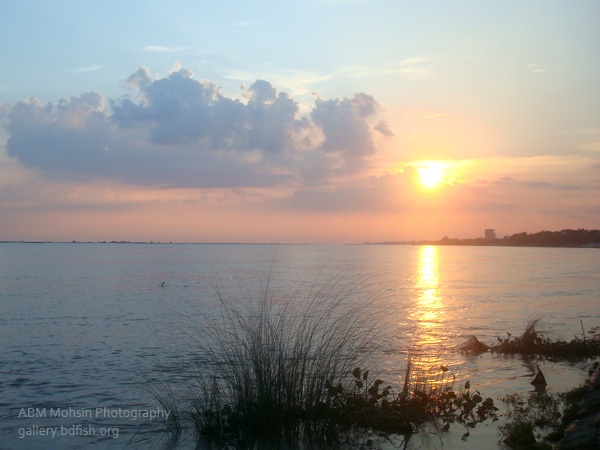
Introduction
River is a long water course that flows down a slope along a bed between banks. According to Banglapedia (2001), 700 rivers flow in Bangladesh. Now a day, most of them have dried out or are extinct due to lack of attention and pollution. About 17 rivers are on the verge of extinction. The delta plain of the Ganges (Padma), Brahmaputra, Jamuna, and Meghna rivers and their tributaries occupy 79% of the country and a water way of total length around 24,140 kilometers (15,000 miles). Total of 58 international rivers flow through Bangladesh. Among them, 55 rivers flow from India and 3 from Myanmar. Sangu and Halda are the only two internal rivers originated and finished within Bangladesh.
Major rivers
A list of major rivers of Bangladesh (Banglapedia, 2021) is given below (according to length)-
| River | Length (km) | Area covered (old districts) in km |
| Surma-Meghna | 670 | Sylhet (290), Comilla (235), Barisal (145) |
| Karatoya-Atrai-Gur-Gumani-Hurasagar | 597 | Dinajpur (259), Rajshahi (258), Pabna (80) |
| Donai-Charalkata-Jamuneshwari-Karatoya | 450 | Rangpur (193), Bogra (157), Pabna (100) |
| Ganges-Padma (Ganges 258, Padma 120) | 378 | Rajshahi (145), Pabna (98), Dhaka and Faridpur (135) |
| Gorai-Madhumati-Baleshwar | 371 | Kushtia (37), Faridpur (71), Jessore (92), Khulna (104), Barisal (67) |
| Matamuhuri | 287 | Chittagong HT and Chittagong |
| Brahmaputra-Jamuna (Jamuna 207) | 276 | Rangpur (140) Pabna (136) |
| Old Brahmaputra | 276 | Mymensingh (276) |
| Kobadak | 260 | Jessore (80) Khulna (180) |
| Bhairab | 250 | Jessore, Khulna |
| Bangshi | 238 | Mymensingh (198) Dhaka (40) |
| Ghaghat | 236 | Rangpur (236) |
| Dhanu-Baulai-Ghorautra | 235 | Mymensingh (126) Sylhet (109) |
| Nabaganga | 230 | Kushtia (26) Jessore (204) |
| Kushiyara | 228 | Sylhet (228) |
| Bhogai-Kangsa | 225 | Mymensingh (225) |
| Dakatia | 207 | Comilla (180) Noakhali (27) |
| Little Feni-Dakatia | 195 | Noakhali (95) Comilla (100) |
| Bhadra | 193 | Jessore (58) Khulna (135) |
| Betna-Kholpotua | 191 | Jessore (103) Khulna (88) |
| Karnafuli | 180 | Chittagong HT, Chittagong |
| Sangu | 173 | Chittagong (80), Chittagong Hill Tracts (93) |
| Chitra | 170 | Kushtia (19) Jessore (151) |
| Kumar | 162 | Jessore, Faridpur |
| Arial Khan | 160 | Faridpur (102) Barisal (58) |
| Dhaleshwari | 160 | Mymensingh, Dhaka |
| Lower Meghna | 160 | from Chandpur to the Bay of Bengal |
| Punarbhaba | 160 | Dinajpur (80) Rajshahi (80) |
| Mathabhanga | 156 | Rajshahi (16), Kushtia (140) |
| Rupsa-Pasur | 141 | Khulna (141) |
| Tista | 115 | Rangpur (115) |
| Buriganga | 27 | Dhaka (27) |
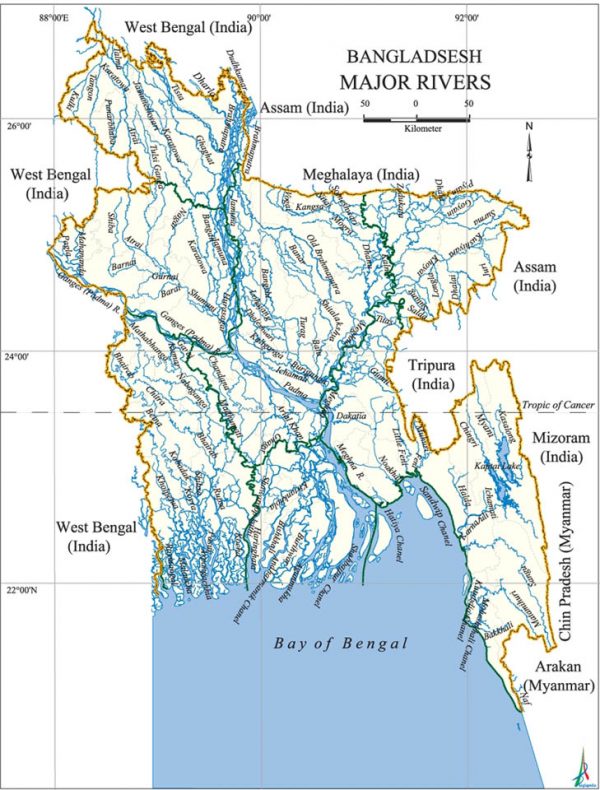
Aquatic lives of our rivers
Our rivers are blessed with many aquatic resources. Many fishes, prawn, frog, snakes and other aquatic lives are found in our rivers. They are-
| Animal groups | Numbers of species |
| Finfish | 267 |
| Prawn | 20 |
| Mollusk | 26 |
| Crab | 4 |
| Frog | 10 |
| Turtle and tortoise | 24 |
| Crocodile | 2 |
| Snakes | 18 |
| Dolphins | 1 |
| Otters | 3 |
| Total | 375 |
Source: Ahmed and Ali (1996), Ali (1997) and Banglapedia (2004).
Damaging of rivers
Our aquatic lives are in threatened condition because of damaging of rivers. Rivers are getting damaged day by day for various reasons. All these reason can be categorized into two main reasons. They are- Manmade and Natural
Manmade reasons:
- Many industries are built by the side of rivers. Wastes from industries polluted water. A World Bank study said four major rivers near Dhaka – the Buriganga , Shitalakhya, Turag and Balu- receive 1.5 million cubic meters of waste water every day from 7,000 industrial units in surrounding areas and another 0.5 million cubic meters from other sources.
- According to Bangladesh Bureau of Statistics data, approximately 162.7 million peoples are living in Bangladesh. Only 59.8% of the total agricultural land (14.3 million ha.) is available to supply food to this huge population. Farmers applied high dose of inorganic fertilizers, pesticides, herbicides and insecticides each year. A portion of these materials is used by the crops but large portion is mixed with water and going down to the lower basins and finally into the rivers.
- Most of our cities and villages are situated near rivers. Household pipelines are connected to the different canals which are finally fall into rivers. Personal care products, oils and high load of organics come with household used water.
- Waste from various water vehicles fall directly into water. Frequently accidents by water vehicles in river that releases toxic liquids into the water. Besides many daily and weekly markets are usually sit besides riverside. Wastes from these places are fall directly into rivers.
- Encroachment has become a serious issue. All across the country, rivers have been converted into a series of ponds through the construction of cross-bunds. Thus, many free-flowing rivers have now become a series of stagnant water bodies.
Natural reasons:
- Flood is a perennial problem or recurrent event of Bangladesh. Almost every year there is flood in one or other part of the country. Floods are the most significant natural hazard in the country causing extensive damage.
- Riverbank erosion an endemic recurrent natural hazard in Bangladesh. It is estimated that about 5% of the total floodplain of Bangladesh is directly affected by erosion. In a typical year, about 2400 km of bank line experiences major erosion.
- Earthquake can change the pathway of any rivers. About 200 years ago, the Brahmaputra River changed its path in the decades after an epic earthquake along the Dauki fault. Over that time, the river shifted about 62 miles (100km) west.
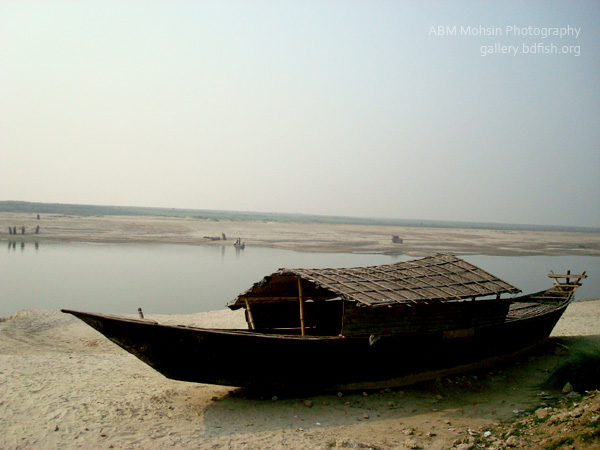
Impact of river damage in aquatic lives:
- Pollution can stimulate or enhance the development, maintenance and proliferation of primary producers, resulting in eutrofication of aquatic ecosystems.
- River damaging may causes depletion of DO of water, causes respiratory hazards for fish and other aquatic animals.
- Increase CO2 level of water, which may causes alkalinity of water.
- Depletion or increase of water pH may cause various health hazards of aquatic lives.
- Due to pollution algal bloom may happens, it may cause oxygen depletion, toxication and sudden death of fish.
- Heavy metals can impair a fish’s ability to smell, disrupting its ability to locate food and protect itself from predatory animals and fish.
- Migratory path of fishes may change due to pollution and damages of rivers.
- It may hamper the breeding season, breeding condition, process, and performance of fish and other aquatics.
- Heavy metals in water may stunt growth, may cause various disease, effects on reproductions.
- Damaging of river may cause extinction of many species of fish and other aquatic animals.
- Alleged pollution –related disease include epidermal papilloma, fin/tail rot, gill disease, hyperplasia, liver damage, neoplasia, and ulceration.
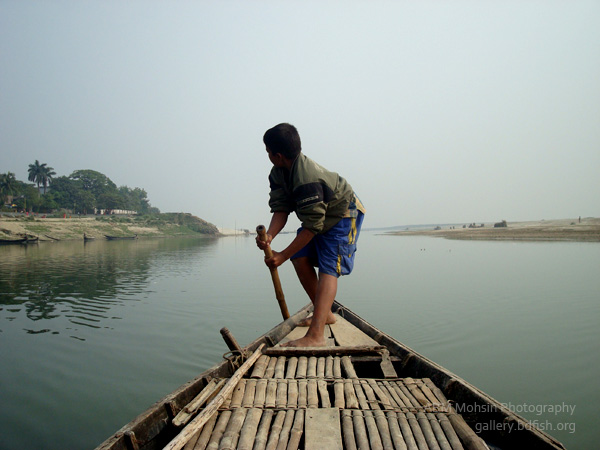
Mitigation of river damaging:
- Awareness for damaging rivers and pollution should be take place among peoples.
- Governments should have take some plans about ‘river management, that include bank revetment, river training infrastructure, and to dredge in appropriate reaches.
- Various acts based on rivers, such as, Bangladesh water act 2013 , National River Protection Commission Act 2013,The Environment Conservation Act 2010, should strictly followed.
- For industries Effluent Treatment Plants (ETPs) have been mandatory by law.
- Treatment plants should have to be set to the drainage system of city drainage.
- Over use of chemical fertilizers or agro-chemicals have to be reduced.
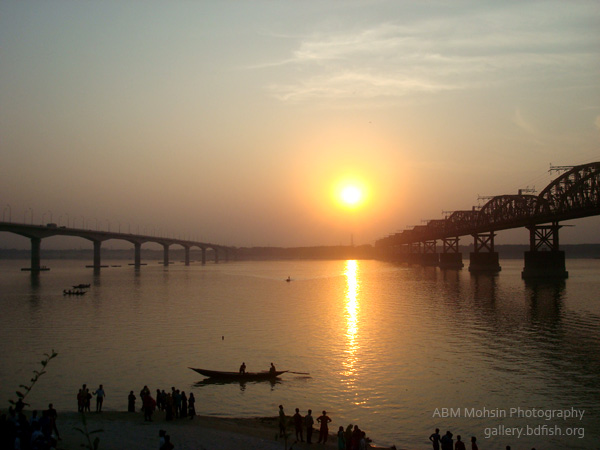
Conclusion:
We have many rivers in our country but day by day these rivers are getting unfavourable for aquatic lives. We have to take good care of our rivers to save our aquatic lives. Public awareness is one of the best effective technique for this. So Let’s save our rivers and save aquatic lives.
Reference:
- Ahmed ATA and Ali ML (1996) Fisheries Resources Potential in Bangladesh and Manpower Development for Fisheries Activities. In: Population Dimension of Fisheries Development and Management Policies of Bangladesh. Dhaka, Bangladesh.
- Ali MY (1997) Fish, water and people, Reflections on inland openwater fisheries resources in Bangladesh. The University Press Limited, Dhaka, 154.
- Azad M (2009) Bangladesh river pollution threatens millions. Reuters. Retrieved on 02 August 2021. https://www.reuters.com/article/us-bangladesh-rivers-idUSTRE54I04G20090519
- Banglapedia. (2004). National Encyclopedia of Bangladesh, Asiatic Society of Bangladesh. 1st edition. Dhaka, Bangladesh.
- Banglapedia (2021) River. Retrieved on 02 August 2021. https://en.banglapedia.org/index.php/River
Banglapedia (2021b) Riverbank erosion. Retrieved on 02 August 2021. https://en.banglapedia.org/index.php/Riverbank_Erosion - Camargo JA and Alonso A (2006) Ecological and toxicological effects of inorganic nitrogen pollution in aquatic ecosystems: A global assessment. Environment International 32(6): 831-849. https://www.sciencedirect.com/science/article/pii/S0160412006000602
- Nishat A (2016) Save River, Save Lives. The Daily Star. Retrieved on 02 August 2021. https://www.thedailystar.net/supplements/new-year-special-2016/save-rivers-save-bangladesh-195025
- Rahman MH, Rahman MS and and Rahman MM (2017), Disasters in Bangladesh: Mitigation and Management. arisal University Journal. Part 1. 4(1):139-163. https://bu.ac.bd/uploads/BUJ1V4I1/13.%20Hashinoor.pdf
- Uddin MJ and Jeong Y (2021) Urban river pollution in Bangladesh during last 40 years: potential public health and ecological risk, present policy, and future prospects toward smart water management. Heliyon. (7:2). e06107. Retrieved on 02 August 2021. https://www.sciencedirect.com/science/article/pii/S2405844021002127
- Wikipedia (2021) Geography of Bangladesh. Retrieved on 02 August 2021. https://en.wikipedia.org/wiki/Geography_of_Bangladesh
- Wikipedia (2021b) List of rivers of Bangladesh. Retrieved on 02 August 2021. https://en.wikipedia.org/wiki/List_of_rivers_of_Bangladesh
Visited 931 times, 1 visits today | Have any fisheries relevant question?
